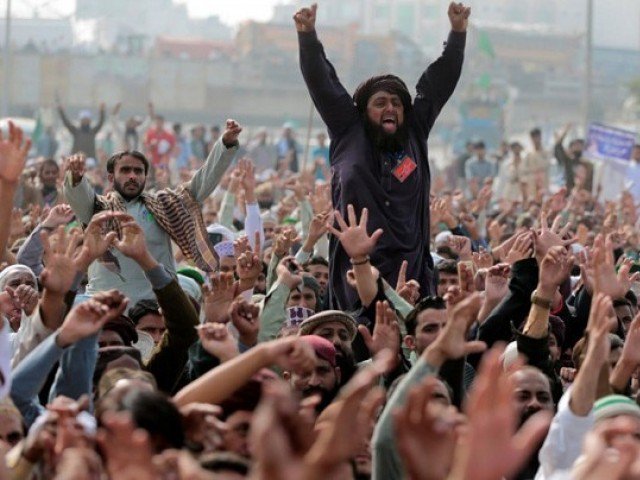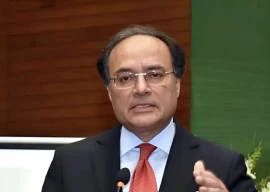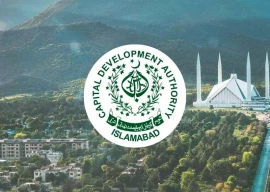
The events from October 31 till November 2 cannot be ruled out as mere reaction of a segment of society trying to take the law into its hands while protesting against the verdict of Supreme Court but these were a reflection of failure of state authorities to manage crisis in a prudent and an efficient manner. Serious doubts about the capability, capacity and political will on the part of the government to protect the lives and property of people still shape the discourse on the nuisance value of those groups who take the law into their own hands. When the federal information minister talked the other day about his government’s resolve not to allow anyone to challenge the writ of the state or promote religious hatred, it was termed rhetoric and an attempt to defuse the crisis by pursuing a policy of appeasement.
It is not for the first time that in the name of religion, intolerant and extremist groups have taken the law into their own hands. Last year in November, the TLP had paralysed the federal capital, Rawalpindi and other parts of the country. The Faizabad sit-in only ended when a written agreement was reached between the TLP and the government.
The October 31 to November 2 crisis also ended when the government reached a written agreement with the TLP which pledged to release those arrested during the sit-in as an attempt to appease the wrongdoers.
The question that arises is: why no lessons were learned the first time the state machinery was put at halt?
Four realities emerge in the wake of how the law-enforcement agencies and the state have dealt with the crisis in Pakistan that has surfaced twice and has possibly found its roots in the structure of society.
Coming first is the absence of a mechanism for crisis management as the Ministry of Interior and other bodies responsible for dealing with a situation threatening the vital interests of state and jeopardising the lives and properties of citizens are incapable of dealing with such a situation when tested. Lack of professionalism, including non-serious approach to respond to a challenging and critical situation, tends to encourage those elements that undermine the writ of the state. It is a shocking reality that the so-called Crisis Management Cell at the Ministry of Interior failed to control the situation and coordinate with the provincial governments against those who disrupted the order.
Second, one way for professional crisis management is to bridge the gap between early warning and early response. The warning was given when the Supreme Court reserved judgment in Aasia Bibi’s case on October 8 that the ultra-religious right faction, particularly the TLP, would violently react in case of her acquittal. The time and space when the judgment was reserved on October 8 and when it was announced on October 31 were sufficient for the state authorities to seriously deal with the warning and to respond in an efficient manner. Yet in the presence of a warning, the response remained mute and meek.
Third, the reality of the nexus between the religious right groups and the powers that be is well known. The crisis which trigged on October 31 after the Supreme Court judgment would have been managed had a sense of responsibility, alertness and aptness existed as far as the state and its security machinery is concerned.
The PML-N government succumbed to the demand of the TLP and Zahid Hamid had to resign. By acquiescing to the demand of the TLP, the state sent out a clear but a wrong message of appeasement. And that is exactly what happened in Pakistan from October 31 till November 2 this year. How the TLP with no legitimate popular and electoral base managed to paralyse most parts of Pakistan? Surely, it had some backing at the state level which made that organisation confident and determined to continue with its defiance of the rule of law. The consistent pattern in Pakistan to cover up things in order to get over a crisis without reaching to its roots and dealing with issues superficially is nothing new.
Pakistan’s predicament is that it is fast descending in the direction of a fragile state. Apparently, a country of 220 million people looks stable but the conglomeration of economic, political, water, energy and environmental crisis along with leadership vacuum augments the threat of a grave crisis engulfing Pakistan from internal and external sides. The way out from back-to-back crises is pursuance of a professional approach by the concerned stakeholders and no compromise as far as the rule of law and justice system is concerned. It is only because when there is mediocre or below mediocre leadership, which also happens to be incompetent and corrupt with meagre knowledge of affairs, that commitment to address issues which trigger crisis is not to be seen to a large extent.
Published in The Express Tribune, November 29th, 2018.
Like Opinion & Editorial on Facebook, follow @ETOpEd on Twitter to receive all updates on all our daily pieces.














1733421998-0/New-Project-(1)1733421998-0-270x192.webp)




COMMENTS (1)
Comments are moderated and generally will be posted if they are on-topic and not abusive.
For more information, please see our Comments FAQ